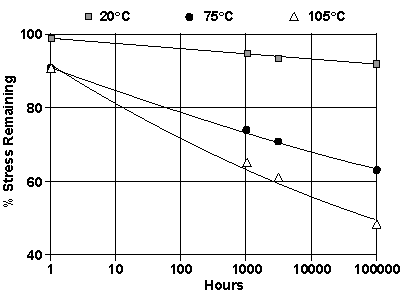By understanding the variables that affect stress relaxation the designer can make choices which optimize the behavior of a contact during its expected life. Once the alloy choice has been made, there are two other important variables that affect stress relaxation: time and temperature. And there are three variables that have less of an impact: initial stress, orientation, and the degree of cold work. The latter is expressed as temper, a traditional designation which reflects the cold reduction by rolling in cold rolled alloys, or the mechanical properties in the case of certain heat-treated alloys.
Although stress relaxation continues over long periods of time, the rate is highest initially and decreases with increasing time. This makes it convenient to plot the data with time on a logarithmic scale against the percent remaining stress, as shown in the figure below for cartridge brass. At a test temperature of 75°C, a little over half the initial stress remains so almost half the contact force has been lost.
Stress relaxation is cumulative over time but the concomitant loss of contact force only occurs during the time the metal is under stress. If the load is completely removed from a spring but later a load is applied to deflect the spring to its original position, the re-stressed spring will again undergo stress relaxation. The total amount of stress relaxation that occurred is the same as would have occurred had the original deflection been maintained for the summation of the two times stressed. For a contact spring that experiences a stress relaxation of 30% in 5 years, that same loss occurs in 15 years when the contact is only stressed 1/3 of the time. Thus, for stress relaxation purposes, the critical time in contact design is the total time under load (not necessarily the design life of the connector).
Most stress relaxation tests don't last as long as the expected design life of connectors. Estimates of % remaining stress beyond these times are typically the result of extrapolation of the curves, possible because they typically become straight (or nearly so) at intermediate times. While this adds uncertainty to the result, it is evident that most of the stress relaxation occurs early in the exposure.
 Figure 1. Stress Relaxation of Cartridge Brass at Several Test Temperatures
Figure 1. Stress Relaxation of Cartridge Brass at Several Test Temperatures